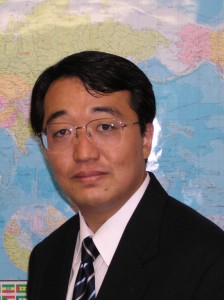緊張と統合:内村鑑三におけるキリスト教と日本の精神
このシリーズでは、私が1994年に執筆した統一神学大学院(Unification Theological Seminary)の神学課程修士論文(Divinity Thesis)を日英二か国語で掲載している。
5.無教会運動の構造の続き
B.反組織原理
無教会派の最も際だった特徴は、その反組織原理である。晩年の内村の最大の関心事は、彼の死後自分の活動がいかなる公式的な形でも継続されないことを確認することであった。彼は自分の死後は自分の聖書雑誌を廃刊し、聖書研究会を解散するように命じた。
いかなる後継者の概念をも拒否する無教会の態度は、今日まで続いている。彼らのモットーは、「生きているキリスト教は後継者を指名する必要はない。だが腐敗した宗教は後継者を必要とする!」である。彼らは常に内村の真の精神に反してセクトに発達し、「無教会教会」に変質してしまわないように注意を払っている。諸集会は常に新鮮であろうと努め、繰り返しや固定的関係を避け、自己の精神的条件を改善するためには他の集会へ移動できるように配慮している。その形態は統一的な集団形成と個人の独立自治を、両立するものである。それは常に流動している。聖書集会は現れては分裂し、分裂を繰り返しては消えて行く。これらすべてが敵意なしで行われるのである。この様な流動性、個人の自由、さらには広範囲な独立といったことを考えれば、無教会には地方の、あるいは全国的な議会、委員会、あるいは事務局といった公式の上部構造が一切存在しないということは、別に驚くには価しないのである。現在までこの運動を叙述した歴史もなければ、会員名簿、統計表もない。
カルダローラは無教会キリスト教を、マックス・ウェーバーやH・R・ニーバーによって形成された宗教社会学の発達モデルの例外であるとみなしている。ウェーバーの提唱によれば、一般的に新宗教は文化的または社会的危機の時代に、カリスマ的指導者が率いるセクトとして出発するという。そのカリスマ的権威は元来革命的で不安定なものであり、もしそのグループが制度化の過程を踏まなければ、創始者の死後に急速に消失してしまう。したがってそのグループは「カリスマの日常化」の過程を通過するのである。この日常化の過程は通常社会学者たちによって制度化と呼ばれている。
V. Structure of Mukyokai Movement (Cont.)
B. Anti-Organization Principle
The most striking characteristics of Mukyokai group is its anti-organizational principle. Uchimura’s main concern during the last years of his life was to ensure that his activities were not continued in any formal fashion after his death. He ordered that both his Biblical magazine(9)and his groups be discontinued.
The Mukyokai rejection of any notion of succession continues to this day. Their motto is “living Christianity does not need to appoint a successor; corrupted religion needs it!” They constantly pay attention not to develop the movement as a sect in opposition to the genuine spirit of Uchimura, thus transforming it into a “non-church church.” The group strive constantly to be fresh and new, to avoid repetition and fixed relationship, and allow the individual to move on to other groups in order to improve his spiritual abilities. Its configuration is one which allows both unified groups and the autonomy of the individual; it is constantly shifting – groups emerge, split and split again, dissolve – all without animosity among the members. Given this fluidity, personal freedom, and widespread independence, it is not surprising that the movement has no formal superstructure at all – no local or national boards, committees, or secretariats; not even a written history of the movement exists and there are no membership rolls or statistics available.(10)
Carlo Caldarola regards the Mukyokai Christianity as an exception of the developmental model of sociology of religion formed by Max Weber and H. R. Niebuhr.(11) Weber proposed that new religious movements generally start out as sects headed by a charismatic leader at the time of cultural crisis or social crisis. That charismatic authority is intrinsically revolutionary and unstable; if the group does not institutionalize, it will die shortly after the founder dies. Hence, the movement undergoes a process of “routinization of charisma.” This process of routinization is commonly referred to by sociologists as institutionalization.(12)
(9)Uchimura utilized several means of spreading his new-found convictions. In 1898, he established Tokyo Dokuritsu Zasshi (Tokyo Independent Magazine), in 1900 Seisho no Kenkyu (Biblical Studies), and in 1901 Mukyokai, the later to expound upon a Christianity completely free of any ecclesiastical organization. Through these magazines, Uchimura reached many brilliant Japanese intellectuals who eventually became his disciples and collaborators.
(10)op cit, Caldarola, p.138.
(11)Ibid., p.143.
(12)Max Weber, Theory of Social and Economic Organization, ed. with introduction by Talcott Parsons, (Glencoe, Ill: The Free Press, 1964), pp. 363ff.
